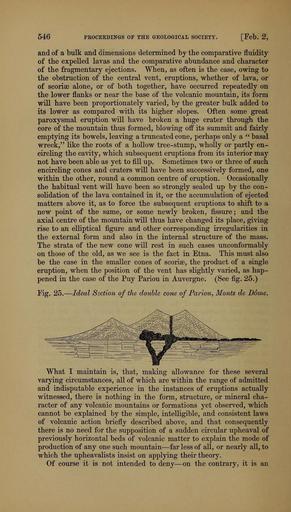MAKE A MEME
View Large Image

| View Original: | The_Quarterly_journal_of_the_Geological_Society_of_London_(12981229043).jpg (1162x2045) | |||
| Download: | Original | Medium | Small | Thumb |
| Courtesy of: | commons.wikimedia.org | More Like This | ||
| Keywords: The Quarterly journal of the Geological Society of London (12981229043).jpg 546 PEOCEEDINGS OF THE GEOLOGICAL SOCIETY Feb 2 <br> and of a bulk and dimensions determined by the comparative fluidity <br> of the expelled lavas and the comparative abundance and character <br> of the fragmentary ejections When as often is the case owing to <br> the obstruction of the central vent eruptions whether of lava or <br> of scoriae alone or of both together have occurred repeatedly on <br> the lower flanks or near the base of the volcanic mountain its form <br> will have been proportionately varied by the greater bulk added to <br> its lower as compared with its higher slopes Often some great <br> paroxysmal eruption will have broken a huge crater through the <br> core of the mountain thus formed blowing off its summit and fairly <br> emptying its bowels leaving a truncated cone perhaps only a basal <br> wreck like the roots of a hollow tree-stump wholly or partly en- <br> circling the cavity which subsequent eruptions from its interior may <br> not have been able as yet to fill up Sometimes two or three of such <br> encircling cones and craters will have been successively formed one <br> within the other round a common centre of eruption Occasionally <br> the habitual vent will have been so strongly sealed up by the con- <br> solidation of the lava contained in it or the accumulation of ejected <br> matters above it as to force the subsequent eruptions to shift to a <br> new point of the same or some newly broken fissure ; and the <br> axial centre of the mountain will thus have changed its place giving <br> rise to an elliptical figure and other corresponding irregularities in <br> the external form and also in the internal structure of the mass <br> The strata of the new cone will rest in such cases unconformably <br> on those of the old as we see is the fact in Etna This must also <br> be the case in the smaller cones of scoriae the product of a single <br> eruption when the position of the vent has slightly varied as hap- <br> pened in the case of the Puy Pariou in Auvergne See fig 25 <br> Fig 25 ” Ideal Section of the double cone of Pariou Monts de Dome <br> What I maintain is that making allowance for these several <br> varying circumstances all of which are within the range of admitted <br> and indisputable experience in the instances of eruptions actually <br> witnessed there is nothing in the form structure or mineral cha- <br> racter of any volcanic mountains or formations yet observed which <br> cannot be explained by the simple intelligible and consistent laws <br> of volcanic action briefly described above and that consequently <br> there is no need for the supposition of a sudden circular upheaval of <br> previously horizontal beds of volcanic matter to explain the mode of <br> production of any one such mountain ” far less of all or nearly all to <br> which the upheavalists insist on applying their theory <br> Of course it is not intended to deny ” on the contrary it is an 36162113 111474 51125 Page 546 Text v 15 http //www biodiversitylibrary org/page/36162113 1859 Geological Society of London Biodiversity Heritage Library The Quarterly journal of the Geological Society of London v 15 1859 Geology Periodicals Smithsonian Libraries bhl page 36162113 dc identifier http //biodiversitylibrary org/page/36162113 smithsonian libraries Information field Flickr posted date ISOdate 2014-03-07 Check categories 2015 August 26 CC-BY-2 0 BioDivLibrary https //flickr com/photos/61021753 N02/12981229043 2015-08-26 14 56 37 cc-by-2 0 PD-old-70-1923 The Quarterly journal of the Geological Society of London 1859 Photos uploaded from Flickr by Fæ using a script | ||||